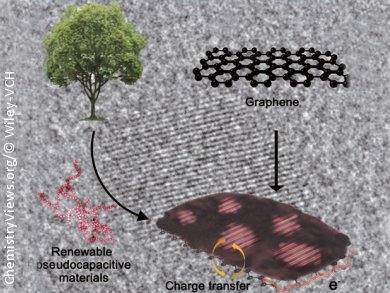Pseudocapacitors are another type of supercapacitor that can improve capacitance. They store energy faradaically through a redox transfer at the electrode surface. However, their performance can suffer from low electrical conductivity and mechanical stabilities. Hybridization of pseudocapacitors derived from renewable materials with electrochemical double layer capacitors may result in an improved supercapacitor.
Ho Seok Park, Kyung Hee University, Seoul, Korea, and colleagues have created a renewable hybrid electrode consisting of lignin nanocrystals confined on reduced graphene oxide (RGO). This concept could be applied for energy storage materials with both high energy and power. The highly electron-conducting RGO (the electochemical double layer capacitor) interacts strongly with the electroactive lignin crystals (the pseudocapacitor) for a fast redox transfer. Thanks to this synergy, the pseudocapacitors showed remarkable rate and cyclic performance with 96 % retention of performance after 3000 cycles.
This work should help in the design of advanced energy storage alternatives to conventional batteries.
- Superior Pseudocapacitive Behavior of Confined Lignin Nanocrystals for Renewable Energy-Storage Materials,
Sung-Kon Kim, Yun Ki Kim, Hyunjoo Lee, Sang Bok Lee, Ho Seok Park,
ChemSusChem 2014.
DOI: 10.1002/cssc.201301061



